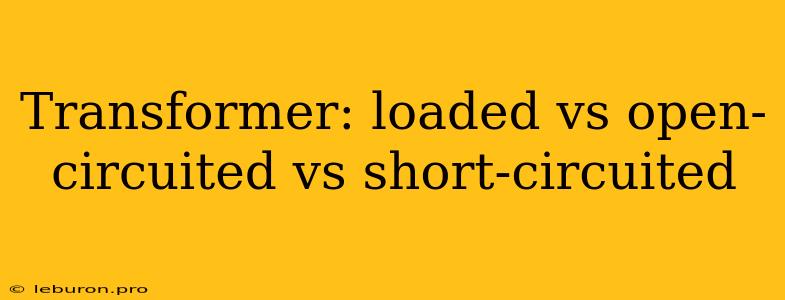Understanding Transformer Operation: Loaded, Open-Circuited, and Short-Circuited States
Transformers are essential components in electrical systems, playing a crucial role in voltage conversion and power distribution. Understanding the different states of a transformer, particularly loaded, open-circuited, and short-circuited, is critical for proper operation and troubleshooting. This article will delve into each state, exploring their characteristics, implications, and the factors that influence their behavior.
Loaded Transformer: Power Transfer at its Core
A loaded transformer is the most common operating state, where it is actively transferring power from the primary to the secondary winding. This power transfer is facilitated by the magnetic field generated by the primary winding, which induces a voltage in the secondary winding. The load connected to the secondary winding determines the amount of current drawn, which directly influences the power transfer.
Here's a breakdown of key aspects of a loaded transformer:
- Current flow: Current flows through both primary and secondary windings. The current in the primary winding is determined by the load on the secondary winding, while the current in the secondary winding is determined by the load itself.
- Voltage drop: There is a voltage drop across the windings due to their internal resistance and leakage inductance. This drop is more significant in loaded conditions due to the increased current flow.
- Power transfer: Power is transferred from the primary to the secondary winding, and this power is delivered to the load.
- Efficiency: The efficiency of a loaded transformer is typically high, with losses primarily occurring due to winding resistance, core losses, and leakage inductance.
Open-Circuited Transformer: A State of No Load
An open-circuited transformer is one where no load is connected to the secondary winding. This means there is no current flowing in the secondary winding, and consequently, no power transfer takes place.
Here's how an open-circuited transformer behaves:
- Current flow: Only a small current, known as the magnetizing current, flows in the primary winding. This current is responsible for establishing the magnetic field in the core.
- Voltage drop: The voltage drop across the windings is minimal due to the low current flow.
- Power transfer: There is no power transfer, as the secondary winding is disconnected.
- Efficiency: The efficiency is technically undefined in this state, as there is no output power.
Short-Circuited Transformer: A Critical State
A short-circuited transformer occurs when the secondary winding is directly connected to a low resistance, effectively creating a short circuit. This state can be highly dangerous, leading to excessive current flow, overheating, and potential damage to the transformer.
Here's what characterizes a short-circuited transformer:
- Current flow: A very high current flows in both primary and secondary windings, limited only by the winding resistance and leakage inductance.
- Voltage drop: The voltage drop across the windings is significant due to the high current flow.
- Power transfer: While there is a high current flow, the voltage across the secondary winding is near zero, resulting in minimal power transfer.
- Efficiency: The efficiency is extremely low due to the high losses associated with the excessive current.
Understanding the Impact of Load on a Transformer
The load connected to a transformer significantly influences its behavior. As the load increases, the current drawn from the secondary winding increases, which in turn affects the primary winding current.
- Increased load: A higher load leads to increased current, causing greater voltage drops across the windings and increased losses.
- Reduced load: A lower load results in reduced current, leading to lower voltage drops and reduced losses.
Transformer Protection: Safeguarding against Short Circuits
To protect transformers from the dangers of short-circuited conditions, various protection mechanisms are employed. These include:
- Fuses: Fuses are designed to melt and break the circuit when excessive current flows, preventing damage to the transformer.
- Relays: Relays monitor current and voltage levels, tripping the circuit if predefined thresholds are exceeded, preventing short-circuit damage.
- Protective devices: Transformers may incorporate internal protective devices, such as overcurrent relays and thermal sensors, to detect and respond to abnormal conditions.
Conclusion: Understanding Transformer States is Crucial
By understanding the different states of a transformer – loaded, open-circuited, and short-circuited – we can gain a deeper understanding of its operation, limitations, and protection needs. This knowledge is essential for engineers, technicians, and anyone working with electrical systems to ensure efficient, safe, and reliable operation of transformers.
